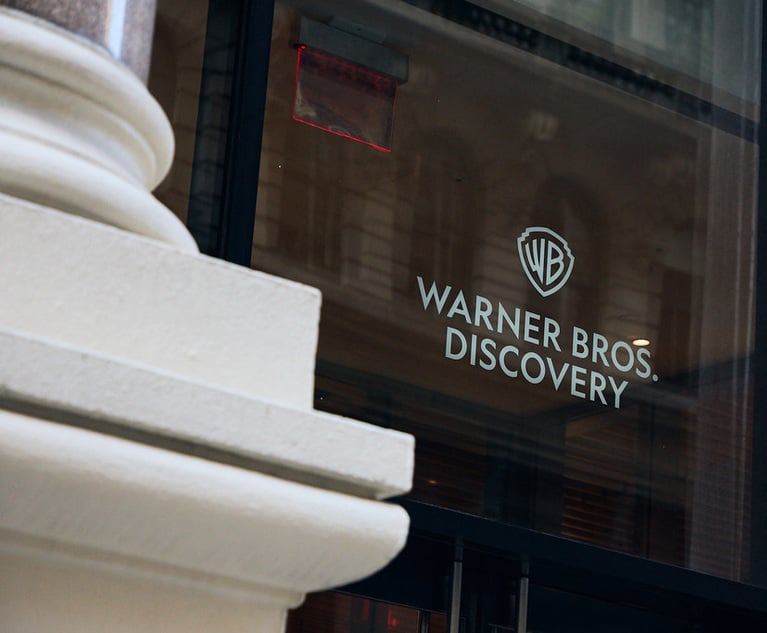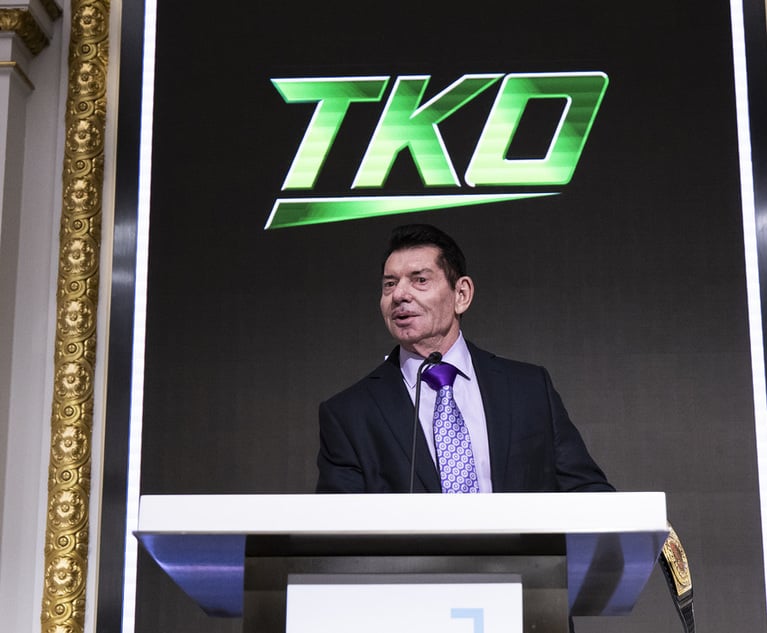IP: The pros and cons of top-level domains
The application date for TLD registration is rapidly approaching.
July 26, 2011 at 08:02 AM
5 minute read
The original version of this story was published on Law.com
Imagine distinguishing your company from others on the Internet by using a web address ending with your business name, instead of the common .com or .net endings. Interested businesses may soon do so by applying to register their own top-level domains (TLD) during a Jan. 12, 2012 through April 12, 2012 application period administered by ICANN.
A top-level domain is the text to the right of the “dot” in a domain name, e.g. “.com” and it serves as the root from which a nearly unlimited number of domain names may spring. The upcoming application process will allow successful applicants to establish their brand, their company name or other terms of interest as a TLD, and then build and administer an array of domain names from that TLD. For example, Apple Inc. could establish www.ipad.apple, www.iphone.apple, www.itunes.apple, etc. by registering “apple” as a TLD.
Establishing a distinct corner of the Internet by obtaining control of a TLD could be extremely beneficial to a business, and to any interested community (communities are also eligible to apply for registration). For example, controlling a TLD provides the owner a new and easily expandable Internet marketing platform, as well as the owner's customers or the interested community with certainty that they are not accidentally visiting an infringing or otherwise unauthorized website.
However, the application process, the ongoing costs involved and the administrative burdens associated with running a TLD registry will temper the interest of many companies and communities. It is not a process to enter into lightly or without thoughtful advance planning and resource allocation.
To begin with, the application fee, covering an initial evaluation for registrability, is $185,000. Both the application and application process are relatively invasive and time-intensive. Among other things, ICANN requires detailed financial and operational plans. Moreover, additional fees may be assessed in certain situations, such as $50,000 or more if an “extended evaluation” is needed due to complications, and up to $5,000 to respond to ICANN's objections regarding registrability. There also may be additional expenses if a third party objects to the application.
In addition, there is the possibility of an auction, if multiple applicants apply to run the same TLD registry. For example, if an apple grower's association and Apple both applied for the TLD “.apple,” an auction may ultimately decide who will own the TLD. Even after obtaining a TLD, the owner must pay ICANN fees amounting to $25,000 or more per year, for 10 years. These fixed and potential costs represent a significant commitment. When combined with the costs of running a TLD registry on a day-to-day basis, and in compliance with ICANN's rules, which require monthly reporting and a host of other affirmative actions, the idea of establishing a brand name TLD may seem daunting. Of course, the return on these investments could be substantial.
For those companies that may wish to obtain a TLD, but decide not to apply during the rapidly approaching application period, there will be additional opportunities in the future. However, the dates of any future application periods are unknown and it will likely be several years before the opportunity arises again. Indeed, many applicants in the upcoming application round can expect the application process to drag well into 2013.
For companies that do not wish to pursue a TLD application, their concerns may turn to brand protection on the Internet due to the upcoming proliferation of new TLDs and associated domain names. The good news for brand owners with concerns about infringement is that individuals and sole proprietors are not eligible for a TLD. Moreover, the financial and operational costs of establishing a TLD are clearly prohibitive for your run-of-the-mill domain name cyber-squatter.
In addition, third parties may use a new ICANN dispute resolution procedure to object to any TLD application that infringes their brand or improperly attempts to reserve an industry-related word. ICANN will publish the basics of all pending applications at ICANN's website so interested parties may monitor pending TLD applications for trademark conflicts. Third parties will have a period of months during which they may file objections against any TLD that is thought to damage their rights and interests.
There are at least four grounds of objection available to challenge a TLD application at ICANN:
- If the TLD infringes the legal rights of a third party
- If the string of letters in the TLD is confusingly similar to an existing TLD
- Based on legal norms of morality and public order under international principles of law (this basis primarily relates to trademark issues)
- Based on objections from a significant portion of an affected community
The dispute procedure itself will closely track ICANN's current Uniform Dispute Resolution Policy, which has been used for domain name disputes for many years and consists of one brief by each party with no discovery.
Whether your company is applying to operate its own TLD or considering defensive measures, either to protect its brands or to prevent a competitor from cornering the market with a TLD composed of an industry-related term, the Jan. 12, 2012 application date is rapidly approaching. The time to closely consider these issues is now.
This content has been archived. It is available through our partners, LexisNexis® and Bloomberg Law.
To view this content, please continue to their sites.
Not a Lexis Subscriber?
Subscribe Now
Not a Bloomberg Law Subscriber?
Subscribe Now
NOT FOR REPRINT
© 2025 ALM Global, LLC, All Rights Reserved. Request academic re-use from www.copyright.com. All other uses, submit a request to [email protected]. For more information visit Asset & Logo Licensing.
You Might Like
View All


SEC Puts Beat Down on Ex-Wrestling CEO Vince McMahon for Not Reporting Settlements
3 minute readTrending Stories
- 1'It's Not Going to Be Pretty': PayPal, Capital One Face Novel Class Actions Over 'Poaching' Commissions Owed Influencers
- 211th Circuit Rejects Trump's Emergency Request as DOJ Prepares to Release Special Counsel's Final Report
- 3Supreme Court Takes Up Challenge to ACA Task Force
- 4'Tragedy of Unspeakable Proportions:' Could Edison, DWP, Face Lawsuits Over LA Wildfires?
- 5Meta Pulls Plug on DEI Programs
Who Got The Work
Michael G. Bongiorno, Andrew Scott Dulberg and Elizabeth E. Driscoll from Wilmer Cutler Pickering Hale and Dorr have stepped in to represent Symbotic Inc., an A.I.-enabled technology platform that focuses on increasing supply chain efficiency, and other defendants in a pending shareholder derivative lawsuit. The case, filed Oct. 2 in Massachusetts District Court by the Brown Law Firm on behalf of Stephen Austen, accuses certain officers and directors of misleading investors in regard to Symbotic's potential for margin growth by failing to disclose that the company was not equipped to timely deploy its systems or manage expenses through project delays. The case, assigned to U.S. District Judge Nathaniel M. Gorton, is 1:24-cv-12522, Austen v. Cohen et al.
Who Got The Work
Edmund Polubinski and Marie Killmond of Davis Polk & Wardwell have entered appearances for data platform software development company MongoDB and other defendants in a pending shareholder derivative lawsuit. The action, filed Oct. 7 in New York Southern District Court by the Brown Law Firm, accuses the company's directors and/or officers of falsely expressing confidence in the company’s restructuring of its sales incentive plan and downplaying the severity of decreases in its upfront commitments. The case is 1:24-cv-07594, Roy v. Ittycheria et al.
Who Got The Work
Amy O. Bruchs and Kurt F. Ellison of Michael Best & Friedrich have entered appearances for Epic Systems Corp. in a pending employment discrimination lawsuit. The suit was filed Sept. 7 in Wisconsin Western District Court by Levine Eisberner LLC and Siri & Glimstad on behalf of a project manager who claims that he was wrongfully terminated after applying for a religious exemption to the defendant's COVID-19 vaccine mandate. The case, assigned to U.S. Magistrate Judge Anita Marie Boor, is 3:24-cv-00630, Secker, Nathan v. Epic Systems Corporation.
Who Got The Work
David X. Sullivan, Thomas J. Finn and Gregory A. Hall from McCarter & English have entered appearances for Sunrun Installation Services in a pending civil rights lawsuit. The complaint was filed Sept. 4 in Connecticut District Court by attorney Robert M. Berke on behalf of former employee George Edward Steins, who was arrested and charged with employing an unregistered home improvement salesperson. The complaint alleges that had Sunrun informed the Connecticut Department of Consumer Protection that the plaintiff's employment had ended in 2017 and that he no longer held Sunrun's home improvement contractor license, he would not have been hit with charges, which were dismissed in May 2024. The case, assigned to U.S. District Judge Jeffrey A. Meyer, is 3:24-cv-01423, Steins v. Sunrun, Inc. et al.
Who Got The Work
Greenberg Traurig shareholder Joshua L. Raskin has entered an appearance for boohoo.com UK Ltd. in a pending patent infringement lawsuit. The suit, filed Sept. 3 in Texas Eastern District Court by Rozier Hardt McDonough on behalf of Alto Dynamics, asserts five patents related to an online shopping platform. The case, assigned to U.S. District Judge Rodney Gilstrap, is 2:24-cv-00719, Alto Dynamics, LLC v. boohoo.com UK Limited.
Featured Firms
Law Offices of Gary Martin Hays & Associates, P.C.
(470) 294-1674
Law Offices of Mark E. Salomone
(857) 444-6468
Smith & Hassler
(713) 739-1250







